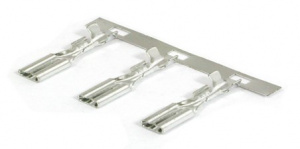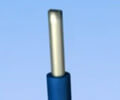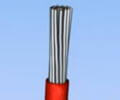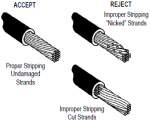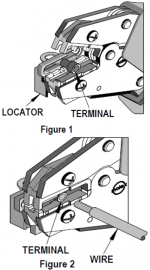Crimping
Contents
Introduction
Crimping is joining 2 pieces of metal or other ductile material (usually a wire and a metal plate) by deforming one or both of them to hold the other. The bend or deformity is called the crimp.
Crimping is developed to replace the need to solder terminations, it provides a high quality connection between a terminal and a wire at a relatively low applied cost. The methods for applying crimp terminations depend on the application, volume, and range from handheld devices to fully automated systems.
Without a thorough understanding of the crimping process, and all the factors that can affect it, the result may not meet expectations.
The three key elements in the crimping process are the terminal, the wire, and the tooling.
Terminal
For most applications, it is not economically practical for connector manufacturers to design a terminal to accept one wire size, one wire stranding, and one insulation diameter (UL type) as well as Mil Specification ( United States defense standard, often called a military standard). Most terminals accommodate many wire sizes, stranding, and a range of insulation diameters, and the terminals are designed to meet acceptable levels over this entire range.
Wire
The wire stranding and insulation type can vary widely within one wire size. Wire strands can be copper, tinned, over coated, or top coated. Wire insulation materials, thickness, and durometers vary from application to application.
Additional Information AWG - American Wire Gauge is a standardized wire gauge system used since 1857 predominantly in North America for the diameters of round, solid, nonferrous, electrically conducting wire.
Wires are of two types:
- Solid: Solid conductors consist of just one strand of metal. They are easier to terminate than stranded conductors. They are also mechanically tough and inexpensive. The major disadvantage of solid conductors is their lack of flexibility.
- Stranded: Stranded conductors are composed of multiple metal strands bunched together in any number of configurations. They are much more flexible than solid conductors, and the higher the strand count, the more flexible they are. While this can add some cost, it is essential for any wire or cable that will need to withstand any kind of movement or flexing.
Procedure
Prepare the Wire
- Check the stranded wire to see if any strands have loosened and expanded to be larger than the wire and the insulation together. If this has occurred, twist the wires to the size they were before they were stripped.
- Check the insulation to ensure that there has been a nice clean cut. Wires with damaged insulation should not be used.
Setup and Operate a Hand Crimp Tool
- Ensure that the hand tool is designed to crimp the size wire and the proper terminal shown on the Hand Crimp Tool Specification sheet.
- Place the terminal in the tool.
- If using a locator, lift the locator and insert the terminal in the proper nest with the barrel up and against the locator bar. Release the locator blade to hold the terminal in position.
- Insert the wire.
- Squeeze the handle.
- Inspect for proper crimp location.
If you are done reading this page, you can go back to Mechanical Subsystem.
